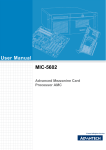Download POWERLINK and Real-Time Linux: A Perfect Match for
Transcript
POWERLINK and Real-Time Linux: A Perfect Match for Highest Performance in Real Applications Josef Baumgartner Bernecker + Rainer Industrie-Elektronik Ges.m.b.H B & R Strasse 1, 5142 Eggelsberg, Austria [email protected] Stefan Schoenegger Bernecker + Rainer Industrie-Elektronik Ges.m.b.H B & R Strasse 1, 5142 Eggelsberg, Austria [email protected] Abstract In the automation industry many discussions around the various Industrial Ethernet concepts like POWERLINK, Profinet and EtherCAT are based on theoretical performance studies. This paper will outline the in reality achievable performance of the open-source POWERLINK technology operating on a standard x86 PC with real-time Linux and its potential application scenarios. The evaluation will include a study on the synchronization quality as well as on the resulting CPU load for large scale applications generated by the network protocol. 1 Introduction of real-time capabilities. Therefore, the Realtime Preemption Patch (RT-Preempt) provided by Ingo Molnar [7] is an ideal base to implement a deterministic POWERLINK master (Managing Node) using Linux. Ethernet has been the standard networking technology in the home and office environment for years. In the automation industry, the conventional field busses are still the dominant communication technology. This is because standard Ethernet could not provide the deterministic behaviour required by many industrial applications. In the meantime there are several ethernet based fieldbusses available on the market. Whereas some provide only soft-realtime capabilities, like PROFINET or EtherNet/IP, some of them are able to fullfill hard real-time requirements needed for industrial applications. Whereas most performance values for other ethernet based fieldbusses are very theoretical, this paper shows the real cycle times which could be reached using openPOWERLINK on a real-time Linux platform. The system load created by the protocol stack is analyzed and the accuracy of the POWERLINK network synchronisation is evaluated. 2 One of these hard real-time Industrial Ethernet protocols is POWERLINK [11]. The availability of the openPOWERLINK network stack for the Linux operating system makes it very easy to implement a software based industrial control application on top of an standard PC running Linux. However, to provide sufficient accuracy for the network timing the operating system must provide some kind 2.1 POWERLINK Communication Principle POWERLINK is a strict, deterministic real-time protocol based on Fast Ethernet (100 MBit) [1]. Time-isochronous transfer of data is supported along with asynchronous communication between network 1 nodes; a part of network bandwidth is reserved for this. Figure 1 shows a POWERLINK communication cycle. maximum length (MTU = Maximum Transfer Unit) must not be exceeded. 2.2 PollResponse Chaining The POWERLINK protocol supports an additional mode called PollResponse Chaining. Instead of requesting the CNs sequentially through PReq frames, the CNs are requested alltogether by the PResMN frame which is sent as multicast. The data, usually sent by the MN in the PReq frames, is mapped into the PResMN frame of the MN. This increases performance if many nodes with small amount of process data are connected, because instead of sending many small packets only one packet containing the data for all CNs needs to be sent. In the conventional POWERLINK cycle a CN is only allowed to send a PRes frame after receiving its PReq frame. With PRes Chaining this rule is obsolete. Now the PRes frame is sent time triggered. Each CN is configured by the MN to send its PRes frame at a specific point in time. It is still possible to use conventional PReq/PRes nodes in combination with PResChaining nodes. Figure 2 shows a POWERLINK cycle with both PRes Chaining and conventional nodes. PollResponse Chaining is specified in [2]. FIGURE 1: POWERLINK cycle A POWERLINK device can be a managing node (MN) or a controlled node (CN). A POWERLINK network has exactly one MN. This regulates activity on the network. All other devices in the network are CNs. The SoC is sent as a multicast and can be received and processed by all other POWERLINK stations in the network. No application data is transported in the SoC, it is only used for synchronization. Immediately after transmitting the SoC, the MN addresses each CN in the network with a PReq (poll request). Each CN responds with a PRes (poll response). The output data designated for a CN is transmitted in the PReq. All stations are addressed in order by the MN with a PReq. Immediately upon receiving the PReq, the addressed station responds with a PRes. This frame is sent as multicast and can therefore be received by the MN as well as by all other CNs in the network. Therefore, the PRes can not only send input data from the CN to the MN, but also allows cross-communication among the CNs. Direct cross-communication allows the times for data exchange between stations to be reduced considerably, since the data need not be copied in the MN. FIGURE 2: POWERLINK cycle with PollResponse Chaining A CN only transmits when it receives a directly addressed request (PReq) from the MN. The MN waits for the response from the CN. This prevents collisions on the network and enables deterministic timing. 2.3 A fixed time is reserved in the network cycle for asynchronous data. Asynchronous data differs from cyclic data in that it need not be configured in advance. Asynchronous data is generated on-demand by a POWERLINK station. Examples are visualization data, diagnostic data, etc. One asynchronous frame can be sent per POWERLINK cycle. The CNs can signal the MN in the poll response frame that they would like to send asynchronous data. The MN determines which station is allowed to send, and shares this information in the SoA (Start of Asynchronous) frame. Any Ethernet frame can be sent as an asynchronous frame (ARP, IP, etc.). However, a Synchronization Parameters Because of the POWERLINK communication principle there is one critical timing parameters in a POWERLINK communication cycle, the SoC Jitter. The MN generates the SoC frame to start a new POWERLINK cycle. For a software solution the accuracy of the SoC generation is mainly determined by the operating system and its network stack. A high-resolution timer is required to provide an accurate cycle timing. Additionally the delay generated in the network driver from receiving the packet until it is sent out to the network determines the cycle quality. 2 3.3 Because the network load for POWERLINK is very high and many small packages will be transferred across the network the interrupt load is very high. Therefore, effective interupt handling is required in the operating system. Furthermore, the performance could be enhanced if the hardware provides interrupt throttling and the network driver is designed to supports this function. FIGURE 3: POWERLINK SoC timing 3 Linux 3.4 The requirements of industrial automation systems generate very high demands on the operating system. For this purpose, POWERLINK was mainly implemented on real-time operating systems such as VxWorks in the past. As the real-time capabilities of the Linux operating system were enormously enhanced in the last years, it grew up to a comparable alternative platform for implementing a POWERLINK MN as a baseline for a competitive automation target. 3.1 openPOWERLINK Stack The openPOWERLINK stack is a POWERLINK stack developed by SYS TEC electronic. SYS TEC published the POWERLINK stack under the OpenSource BSD license[11]. openPOWERLINK contains all functionalities and services required for implementing a POWERLINK MN and CN. It runs on Linux and other operating systems and platforms. Although there are Linux solutions available for other Ethernet based fieldbusses, these are mostly Linux drivers for proprietary hardware. With the openPOWERLINK stack a pure software based solution is available which runs on a standard PC and no proprietary hardware is needed. Realtime Preemption Patch The standard Linux kernel only meets soft real-time requirements but there are several real-time extensions available for Linux right now. One of them is the Realtime Preemtpion Patch (RT-Preempt) developed by Ingo Molnar. Unlike other Linux real-time extensions RT-Preempt doesn’t use a micro-kernel but brings hard real-time capabilities directly into the Linux kernel. The big advantage of this solution is that the user can use his standard linux tools for development, using the POSIX API for his applications and doesn’t need to lern special real-time APIs. 3.2 Interrupt Load Figure 4 shows the software architecture of the openPOWERLINK stack. The Linux implementation of the openPOWERLINK stack runs completely in kernel space. The interface to the user space application is provided by the EPL API Layer. High Resolution Timers Precondition for an accurate SoC timing in a POWERLINK MN is a very accurate system timer. The high-resolution timers introduced by Thomas Gleixner are part of the Linux kernel since 2.6.16. The new timer system does no longer depend on the periodic tick of the operating system and allows nanoseconds resolution. However, the resolution depends on the available timer hardware of the system. On an Intel X86 architecture there are different clocksources available (hpet, tsc, acpi pm) which provide a usable timer resolution in the microsecond range. FIGURE 4: architecture 3 openPOWERLINK software GHz, 1 GByte DDR2 PC2-5300 DRAM and a 40GB harddisk drive. The Intel 945GME chipset contains the Graphics Media Accelerator GMA 950. The onboard network interface based on a Realtek 8111B Gigabit Ethernet adapter was used for the network stress tests. The POWERLINK network was connected through the second onboard Intel 82573L based Ethernet controller. To provide maximum performance the openPOWERLINK stack does not use the Linux network drivers but provides its own optimized network drivers. 4 Performance Evaluation In our evaluation we analyzed the lowest POWERLINK cycle times which could be achieved on a Linux POWERLINK MN with the current openPOWERLINK stack and how much system load it generates. Additionally we measured the quality of the POWERLINK timing on the network. 4.1 Embedded PC The second APC810 was equipped with a Intel Celeron M 423 processor. The processor clock was reduced to 533MHz to simulate the processing power of an embedded system. The remaining hardware configuration was the same as with the first APC810. Test Environment Software The following test setup was used for the evaluation: The installed operating system was a 32-bit version of Ubuntu 10.04LTS Desktop running a 2.6.31.12rt21 kernel. The current openPOWERLINK network stack version 1.7 was installed. • MN: APC810 industrial PC • CNs: B&R X20 BC0083 (X20 DI4371, X20 DO4322) • B&R POWERLINK Analyzer X20 HB8815 4.1.2 Figure 5 shows the testsytem with three bus controllers connected to the MN. For the POWERLINK CNs, B&R X20 BC0083 bus controllers [4] were used. A digital input modul X20DI4371 [5] and a digital output modul X20DO4322 [6] was connected to each bus controller. The DI4371 module is equipped with four digital inputs, the DO4322 module is equipped with four digital outputs. In contrast to other systems a B&R POWERLINK CN is not restricted to a few I/O ports. If additional I/O was needed, one would typically add additional I/O modules to one node. Up to 253 I/O modules could be connected to a single bus controller. As we would like to evaluate the performance on differently sized networks we used a changing amount of bus controllers and connected only one digital input and one digital output module. The PResMN frame from the MN contains the data for the digital outputs. The PRes frames from the CNs contain the data of the digital inputs and some additional status information. Table 1 shows the size of the payloed for the differently sized networks. FIGURE 5: POWERLINK Test System 4.1.1 POWERLINK CNs POWERLINK MN The POWERLINK MN test systems were implemented on B&R APC810 industrial PCs.[3] We used two differently equipped PCs to compare the results of a high-end industrial PC with a solution in the range of current embedded platforms. Number of CNs Input size in Bytes (Sum of all CNs) Output size in Bytes High-End Industrial PC The first APC810 was equipped with a Intel Core2Duo U7500 dual core processor running at 1.06 TABLE 1: 4 3 18 10 60 20 120 40 240 3 10 20 40 Payload Size of test system 4.1.3 4.3 POWERLINK Analyzer Due to the limited accuracy, network timing measurment with WireShark was not sufficient. Therefore, a B&R POWERLINK analyzer was connected in order to get high quality network timing measurements. The implementation of a special MAC controller (openMAC) in a FPGA makes it possible for the POWERLINK analyzer to measure timestamps of network frames with a resolution of 20ns. 4.2 4.3.1 1. Idle The first measurement was done on an idle system as a reference for the different stress tests. To evaluate which cycle times could be achieved and how much system load the POWERLINK stack generates with differently sized networks we connected a changing amount of CNs to the POWERLINK MN and measured the system load. Table 2 and 3 show the results of the system load measurement. 250 µs 500 µs 1 ms 2 ms 5 ms 10 ms 3 37% 18% 8% 3% < 1% < 1% 2. CPU load For the CPU stress test, the tool cpuburn was used [9]. It is designed to load X86 CPUs as heavily as possible for the purposes of system testing. 3. Hard Disk I/O Load The tool dd was used to read and write large amounts of data from and to the hard disk drive. of CNs 20 40 N/A N/A 43% N/A 21% 39% 9% 18% 4% 6% < 1% 2% 4. USB I/O Load As for the hard disk, dd was used on an USB drive to produce USB I/O load. 5. Network Load Heavy network stress was caused by an external flood ping on the first Ethernet interface. TABLE 2: System Load Measurement, High-End PC 250 µs 500 µs 1 ms 2 ms 5 ms 10 ms 3 50% 25% 11% 5% < 1% < 1% Number 10 N/A 29% 14% 7% 2% 1% of CNs 20 N/A 50% 23% 11% 3% 1% Methodology We measured the SoC timing accuracy while the system was stressed with different stress tests. Figure 5 shows the test system which was used for the measurements. The following stress tests were applied: Cycle Time and System Load Number 10 N/A 28% 14% 5% 1% < 1% SoC Timing Evaluation 6. Scheduling load Heavy process scheduling load was caused by hackbench [10]. It spawns over a hundred processes which are communicating by sending signals to each other. 40 N/A N/A 41% 19% 7% 3% 7. Miscellaneous Load To cause miscellaneous system load a linux kernel compilation was started. TABLE 3: System Load Measurement, Embedded PC 4.3.2 Results The following section shows the results of the SoC jitter measurements. Cycle times of 250 µs could be reached on both systems. The measured system load is the load of all POWERLINK threads on a single core. This means that the overall system load on the dual core system is much less and leaves enough processing power for applications. High-End System, Intel Core2Duo The following test parameters were applied: 5 TABLE 4: SoC Jitter, Intel Core2Duo 100 0 −50 Periodic Jitter (us) 500 50 550 Deviation 48.8 µs 25.9 µs 52.6 µs 56.5 µs 61.9 µs 53.2 µs 54.3 µs Cycle Time (µs) −100 Max Cycle 548.8 µs 525.9 µs 552.6 µs 556.5 µs 560.4 µs 553.2 µs 552.4 µs 450 Min Cycle 460.3 µs 474.6 µs 451.2 µs 443.5 µs 438.1 µs 447.4 µs 445.7 µs 400 Stress Tests Idle CPU Hard Disk I/O USB I/O Network Scheduling Miscellaneous 600 500 µs 10 · 106 hpet 2.6.31.12-rt21 Reference Cycle Time: Measured Cycles: Clock Source: Linux Kernel: IDLE CPU HDD USB NET SCHED MISC Stress Tests 20 0 −20 The measured SoC jitter is in the expected range. On the high-end system a maximum deviation of 61.9 µs could be reached. On the embedded system a maximum deviation of 109.2 µs could be reached. However, it was not clear why the jitter was so high on an idle system and gets smaller if the CPU is heavily loaded. −40 Periodic Jitter (us) 520 500 480 440 −60 460 Cycle Time (µs) Conclusion 40 540 60 560 FIGURE 7: SoC Jitter, Intel Celeron IDLE CPU HDD USB NET SCHED 5 MISC Conclusion and Future Work Stress Tests The performance evaluation showed that the Linux operating system together with RT-Preempt is an ideal platfrom for implementing a high-quality POWERLINK MN. The high-resolution timers ensure a very high cycle time accuracy which is sufficiant for many industrial applications. However, it is not clear why we get the best results for the SoC jitter measurement when the CPU is heavily loaded. This needs further investigation. FIGURE 6: SoC Jitter, Intel Core2Duo Embedded System, Intel Celeron The following test parameters were applied: Reference Cycle Time: Measured Cycles: Clock Source: Linux Kernel: Stress Tests Idle CPU Hard Disk I/O USB I/O Network Scheduling Miscellaneous TABLE 5: Min Cycle 396.1 µs 473.2 µs 400.3 µs 397.2 µs 456.8 µs 463.7 µs 402.5 µs 500 µs 10 · 106 hpet 2.6.31.12-rt21 Max Cycle 597.4 µs 532 µs 603.2 µs 609.2 µs 543 µs 533.1 µs 600.5 µs The cycle time could be lowered down to 250 µs which allows the implementation of industrial systems which require very low cycle times, such as motion control systems. The generated system load is low enough to implement small systems using an embedded platform or medium systems by using highend industrial PCs. Due to the measured values there is evidence that even larger networks could be realized without problems. We will continue testing with larger networks and other architectures in the future to provide comprehensive performance values. Deviation 103.9 µs 32 µs 103.2 µs 109.2 µs 43.2 µs 36.3 µs 100.5 µs SoC Jitter, Intel Celeron With the openPOWERLINK stack an OpenSource solution is available for Linux which allows 6 2009, Ethernet POWERLINK Standardisation Group, V 0.0.3 everyone to implement a cost effective industrial control solution on top of a standard x86 PC. The current implementation of the openPOWERLINK stack implements its own proprietary network interface driver. Whereas this assures the maximum performance it limits the stack to use one of the few network cards, supported at the moment. To avoid implementing drivers for the huge amount of network cards available on the market, the design of the stack should be changed to use standard Linux network drivers. This may require some optimizations in the network subsystem like preallocated SKBs or a optimized traffic shaper to get the needed performance for a deterministic real-time Ethernet protocol. Additionally this whould assure compatibility with future kernel versions. [3] APC 810 User’s Manual, Version 1.20, October 2009, Bernecker + Rainer Industrie-Elektronik Ges.m.b.H, Austria [4] X20 System User’s Manual, Version 2.10, 9.6 BC0083, Bernecker + Rainer IndustrieElektronik Ges.m.b.H, Austria [5] X20 System User’s Manual, Version 2.10, 9.6 DI4371, Bernecker + Rainer Industrie-Elektronik Ges.m.b.H, Austria [6] X20 System User’s Manual, Version 2.10, 9.6 DO4322, Bernecker + Rainer IndustrieElektronik Ges.m.b.H, Austria B&R will continously drive the further development of the openPOWERLINK stack on Linux and its long term goal will be to bring POWERLINK functionality into the official kernel sources enabling everyone using a standard Linux machine to use it for industrial control applications. [7] The RT Wiki, CONFIG PREEMPT RT Patch, https://rt.wiki.kernel.org/index.php/ CONFIG PREEMPT RT Patch [8] The RT Wiki, High resolution timer design notes, https://rt.wiki.kernel.org/index.php/ High resolution timer design notes References [9] The cpuburn homepage, http://pages.sbcglobal.net/redelm/, Robert Redelmeier [1] EPSG Draft Standard 301, Ethernet POWERLINK, Communication Profile Specification, 2008, Ethernet POWERLINK Standardisation Group, V 1.1.0 [10] Hackbench http://devresources.linuxfoundation.org/craiger/hackbench/ [2] EPSG Working Draft Proposal 302-C, Ethernet POWERLINK, Part C: PollResponse Chaining, homepage, [11] openPOWERLINK Protocol Stack http://openpowerlink.sourceforge.net/ 7 Source,





















